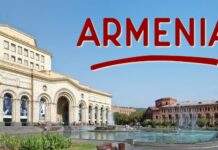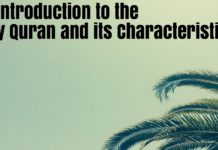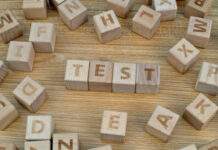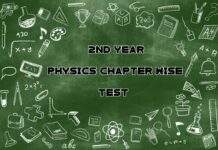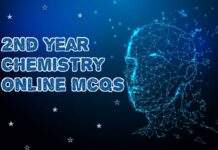2nd year physics chapter wise test session is available on this website. Teachers and holders of an AQ Academy can give you the opportunity to download a chapter of Physics class 12 for a test session. 2nd year Physics test chapter no. 12 to chapter no. 22 is here but here I will provide you the FSC part 2 Physics test chapter for free. I will provide you Online test facility totally free of different subjects.
2nd year physics chapter wise test
Table of Contents
Chapter No 12
2nd year physics chapter wise test AQ Academy
Q.1 Circle the Correct Answers. (6×1=6)
i. Total flux through a closed surface depends on:
(A) Shape of surface (B) Charge enclosed only (C) Medium only (D) Charge and Medium
ii. Electric flux does not depend upon:
(A) Medium (B) Shape of a closed surface
(C) Charge enclosed (D) Medium and charge enclosed
iii. A particle carrying a charge of 2e falls through a potential difference of 3 V. The energy acquired by it is:
(A) 9.6 × 10 J -18 (B) 9.6 × 10 J -19 (C) 1.6 × 10 J -19 (D) 9.6 × 10 J -17
iv. The work done in bringing a unit positive charge from infinity to that point in an electric field is called:
(A) Potential (B) Potential difference (C) Absolute potential (D) All of these
v. A charge of 10 C between two parallel plates 1 cm apart experiences a force of 10 N: -10 -5
(A) 10 V (B) 102V (C) 103V (D) 104V
vi. Charge carriers in electrolytes are:
(A) Protons (B) Electrons(C) Holes (D) Positive and Negative ions
Q.2 Write short answers to the following questions. (8×2=16)
- Describe five/four properties of electric field lines.
- Define electric potential difference with the unit.
iii. Do electrons tend to go to regions of high potential or of low potential?
- What is the difference between electric and gravitational force?
- Define the unit of Capacitance gives its units.
- How can you identify which plate of a capacitor is negatively charged?
vii. Define dielectric constant give its mathematical form.
viii. What is the time constant?
NOTE: Attempt the long question. (5+3=8)
3(a) Describe Millikan’s method to find the charge on an electron.
(b) The time constant of a series RC circuit is t = RC. Verify that an ohm time farad is equivalent to a second.
MCQs Ans Key
Q:1 (D) Q:2 (B) Q:3 (B) Q:4 (C) Q:5 (C) Q:6 (D)
Chapter No 13
2nd year physics chapter wise test AQ Academy
Q.1 Circle the Correct Answers. (6×1=6)
i. Specific resistance of a material depends upon:
(A) Length (B) Area (C) Temperature (D) Both A & B
ii. mho-m is the unit of -1
(A) Resistance (B) Resistivity (C) Conductance (D) Conductivity
iii. Temperature coefficient of resistance (α) is equal:
(A) Rt+RoR Δt o(B) Ro−RtR Δt o(C) Rt−RoR Δt o(D) None of these
iv. Resistance tolerance for gold colour is:
(A) 50% (B) 30% (C) 20% (D) 5%
v. In carbon resistors, which colour band indicates the tolerance of ±10%?
(A) White (B) Silver (C) Gold (D) Violet
vi. Potentiometer is used to:
(A) Compare emf of two cells (B) Detect internal resistance of cells
(C) Measure potential difference (D) All of these
Q.2 Write short answers to the following questions. (8×2=16)
- A wire of length 10 m has a resistance of 100 Ω. If the wire is stretched to increase its length three times what will be its new resistance.
- Differentiate between resistance and resistivity, their units.
iii. Define Tolerance, give an example.
- Give colour code of carbon resistor.
- What is meant by the tolerance? Find the resistance of the resistor with colors Red-violet-orange-silver.
- How is rheostat used as potential divider?
vii. What areThermistor?
viii. Is the filament resistance lower or higher in a 500W 220V light bulb than in 100W 220V bulb?
NOTE: Attempt the long question. (5+3=8)
3(a)What is wheat stone bridge? Give its principle, construction, and working. How can it be used to find unknown resistance of a write?
(b) The resistance of an iron wire at is 0°C. What is the resistance at 500 °C if temperature. Coefficient of resistance of iron 5.2 x 10-4 K-1.
MCQs Ans Key
Q:1 (D) Q:2 (D) Q:3 (C) Q:4 (D) Q:5 (B) Q:6 (D)
Chapter No 14
2nd year physics chapter wise test AQ Academy
Q.1 Circle the Correct Answers. (6×1=6)
i The force on current carrying conductor placed in magnetic field is expressed by:
(A) F = I .LB (B) F = I ×LB (C) F = ×I2 LB (D) F = I ×BL
ii The value of permeability of free space in SI unit is:
(A) 4π × 10-9 Wb A -1m-1 (B) 4π × 10-7 Wb A-1 m-1
(C) 4π × 10-10 Wb A-1 m-1 (D) 4π × 107 Wb A 1m1
iii The field inside a solenoid is given by:
(A) μonI (B) μon I2 (C) μon2I(D) μoNI
iv When a charged particle is projected opposite to the direction of magnetic field, it experiences a force equal to:
(A) qvB cos θ (B) qvB sin 90°(C) qvB (D) zero
v The e/m of a neutron is:
(A) less than electron (B) zero (C) greater than election (D) the same as electron
vi The value of e/m is smallest for:
(A) Proton (B) Electron (C) β − particle (D) Positron
Q.2 Write short answers to the following questions. (8×2=16)
- Describe the change in magnetic field inside a solenoid carrying a steady current I if length of solenoid is doubled but number of turns remains the same.
- Write two uses of CRO.
iii. How brightness on screen of CRO can be controlled?
- What is C.R.O? Also give its two uses.
- How can you explain the wave form of various voltages formed in CRO?
- What is the function of ‘X’ and ‘Y’ plates in C.R.O?
vii. Is it possible to orient a current loop in a uniform magnetic field such that the loop will not tend to rotate?
viii. Define right hand rule for determining the direction of the magnetic field.
NOTE: Attempt the long question. (5+3=8)
3(a) How e/m of an electron can be determined? Explain.
(b) A 20.0 cm wire charging a current of 10.0 A is placed in a uniform magnetic field of 0.30 T. If the wire makes an angle of 40° with the direction of magnetic field. Find the magnitude of the force acting on the wire.
MCQs Ans Key
Q:1 (B) Q:2 (B) Q:3 (A) Q:4 (D) Q:5 (B) Q:6 (A)
Chapter No 15
2nd year physics chapter wise test AQ Academy
Q.1 Circle the Correct Answers. (6×1=6)
i A metal rod of 1m is moving at a speed of 1ms -1 in a direction making an angle 30° with 0.5 T magnetic field. The emf produced is:
(A) 0.25 N (B) 2.5 N (C) 0.25 V (D) 2.5 V
ii The negative sign with induced emf in Faraday’s law is in accordance is in:
(A) Lenz’s law (B) Amperes law (C) Gauss law (D) Boyle’s law
iii Lenz’s Law deals with:
(A) Magnitude of emf (B) Direction of emf
(C) Direction of induced current (D) Resistance
iv Energy density in inductor is given by:
(A) ½ B/μo (B) ½ B/μo2 (C) ½ B2 /μo (D) ½ B2 /μo2
v Which one of the following is not present in an A.C generator?
(A) Armature (B) Magnet (C) Slip rings (D) Commutator
vi The principle of an electric generator is based upon:
(A) Ampere’s law (B) Faraday’s law (C) Coulomb’s law (D) Kirchhoff’s law
Q.2 Write short answers of the following questions. (8×2=16)
- Name four methods to produce induce emf.
- Is it possible to change both the area of the loop and the magnetic field passing through the loop and still not have induced emf in the loop?
iii. Does the induced emf always act to decrease the magnetic flux through a circuit?
- In a certain region the earth’s magnetic field point vertically down, when a plane flies due to north, which wingtip is positively charged?
- A square loop of wire is moving through a uniform magnetic field. The normal to the loop is oriented parallel to the magnetic field. Is an emf induced in the loop? Give a reason for your answer.
- A suspended magnet is oscillating freely in a horizontal plane. The oscillations are strongly damped when a metal plate is placed under the magnet. Explain why this occurs?
vii. On which factors the mutual inductance of the two coils depends?
viii. How would you position a flat loop of wire in a changing magnetic field so that there is no emf induced in the loop?
NOTE: Attempt the long question. (5+3=8)
3(a) Derive the formula for energy stored in an inductor. Also define inductor.
(b) A solenoid has 250 turns and its self inductance is 2.4 m H. What is the flux through each turn when the current is 2A? what is induced emf when the current changes at the rate of 20As-1
MCQs Ans Key
Q:1 (C) Q:2 (A) Q:3 (C) Q:4 (D) Q:5 (D) Q:6 (B)
Chapter No 16
2nd year physics chapter wise test AQ Academy
Q.1 Circle the Correct Answers. (6×1=6)
i In case of capacitor the unit of reactance is:
(A) Ohm (B) Mho (C) Farad (D) Henry
ii The combined effect of resistance and reactance is knows as:
(A) Inductance (B) Conductance (C) Resistance (D) Impedance
iii In R-L series circuit phase angle is given by:
(A) θ = tan−1 1ωLR(B) θ = tan−1ωLR (C) θ = tan−1 RωL(D) θ = tan−1 ωLR
iv The expression P = VI holds only when current and voltage are:
(A) In phase (B) Out of phase(C) At right angle to each other (D) At angle of 120o
v At resonance frequency, the impedance of RLC series circuit is:
(A) Maximum (B) Minimum (C) Zero (D) Infinite
vi In RLC series circuit, the condition for resonance is:
(A) XL < XC (B) XL > XC (C) Z > XC (D) XL = XC
Q.2 Write short answers of the following questions. (8×2=16)
- Define peak value and peak to peak value of A.C voltage?
- What is the main reason for the worldwide use of A.C?
iii. What do you mean by phase lag and phase lead?
- Which quantity, voltage or current leads in a capacitor and by how much angle?
- A 100 μF capacitor is connected to an alternating voltage of 24 V and frequency 50 Hz. Calculate the currentin the circuit.
- What is meant by inductive and capacitive reactance.
vii. How power is calculated in an A.C circuit? Write its formula.
viii. Write down two advantages of the phase A.C supply.
NOTE: Attempt the long question. (5+3=8)
3(a) What is R-C series circuit? Find the impedance of R-C series circuit.
(b) An A.C voltmeter reads 250 V. What is its peak and instantaneous values if the frequency of alternating voltage is 50 Hz?
MCQs Ans Key
Q:1 (A) Q:2 (D) Q:3 (D) Q:4 (A) Q:5 (B) Q:6 (D)
Chapter No 17
2nd year physics chapter wise test AQ Academy
i. Example of a ductile substance is:
(A) Glass (B) Wood (C) Lead (D) Oxygen
ii. The Young’s Modulus of Mercury is:
(A) 70 × 109Nm-2 (B) 15 × 109Nm-2 (C) Zero (D) 91 × 109Nm-2
iii. Conductors have conductivities of the order of:
(A) 103 (Ωm)−1(B) 107 (Ωm)−1(C) 105 (Ωm)−1(D) 109 (Ωm)−1
iv Which type of impurity is to be added to a pure semiconductor crystal to provide holes?
(A) Monovalent (B) Trivalent (C) Tetravalent (D) Pentavalent
v In p-type substances, the minority carriers are:
(A) Electrons (B) Protons (C) Holes (D) Neutrons
vi A solid having regular arrangement of molecules throughout its structure is called:
(A) Amorphous solid (B) Polymeric solid (C) Glassy solid (D) Crystalline solid
Q.2 Write short answers of the following questions. (8×2=16)
- What is difference in elasticity and plasticity?
- Define ultimate tensile strength (UTS) and fracture stress.
iii. Define modulus of elasticity. Show that unit of modulus of elasticity and stress are same.
- What are ductile materials, Give its two examples.
- Which is more elastic, steel or rubber? Why?
- Differentiate between insulators and conductors.
vii. Define the curie temperature.
viii. Where are squids? Explain.
NOTE: Attempt the long question. (5+3=8)
3(a) What is meant of strain energy? How can it be determined from the force extension graph?
(b) A cylindrical copper wire and a cylindrical steel wire each of length 1.5 m and diameter 2.0 mm are joined at one end to form a composite wire 3.0 m l ong. The wire is loaded until its length becomes 3.003 m. Calculate the strain in copper and steel wires and the force applied to the wire. (Young’s modulus of copper is 1.2 × 10 Pa and for steel is ). 11 2.0 × 10 Pa11.
MCQs Ans Key
Q:1 (C) Q:2 (C) Q:3 (B) Q:4 (B) Q:5 (A) Q:6 (D)
Chapter No 18
2nd year physics chapter wise test AQ Academy
Q.1 Circle the Correct Answers. (6×1=6)
i When a PN-junction is reverse biased the depletion region is:
(A) Widened (B) Narrowed (C) Normal (D) None of these
ii Photovoltaic cell is formed from:
(A) Arsenic (B) Carbon (C) Germanium (D) Silicon
iii Which component of the transistor has greater contraction of impurity:
(A) Base (B) Emitter (C) Collector (D) Emitter and collector
iv For non-inverting amplifier if R1 = ∞Ω, R2 = 0 Ω then gain of amplifier is:
(A) -1 (B) 0 (C) +1 (D) Infinite
v LDR becomes necessary when op-amp is used as a:
(A) Night switch (B) Inverter (C) Rectifier (D) Comparator
vi In a comparator circuit, when the intensity of light decreases, the resistance of LDR:
(A) RL increases (B) RL decreases (C) VR decreases (D) V_ increases
Q.2 Write short answers to the following questions. (8×2=16)
- Define depletion region and potential barrier.
- What is a potential barrier in a p-n junction?
iii. What is the role of a potential barrier in a diode. How is it formed in a diode?
- How does the current flow in forward and reverse biased diode?
- What is the biasing requirement of the junction of a transistor for its normal operation?
- Write some important uses of an operational amplifier.
vii. Write briefly about the operational amplifier.
viii. What is the principle of the virtual ground? Write the gain of inverting amplifier.
NOTE: Attempt the long question. (5+3=8)
3(a) What is meant by rectification explain full-wave rectification by a bridge rectifier. What is the use of a filter circuit?
(b) What is an operational amplifier? Discuss the action of op. amp as inverting and non-inverting amplifiers. Also, calculate voltage gain in each case.
MCQs Ans Key
Q:1 (A) Q:2 (A) Q:3 (C) Q:4 (C) Q:5 (D) Q:6 (A)
Buy Books Suggested By Experts
Chapter No 19
2nd year physics chapter wise test AQ Academy
Q.1 Circle the Correct Answers. (6×1=6)
i The dimensions of Plank’s constant are the same as that of:
(A) Energy (B) Power (C) Acceleration (D) Angular momentum
ii Joule-second is the unit of:
(A) Energy (B) Wein’s constant (C) Planck’s constant (D) Boyle’s law
iii The energy of a photon is given by:
(A) mv2 /2 (B) hf (C) Vo e (D) mo c2
iv Potassium cathodes in photocell emit electrons for a light:
(A) Visible (B) Infra-red (C) Ultra-violet (D) X-rays
v Light of 4.5 eV is incident on a Cesium surface and stopping potential is 0.25 eV, maximum K.E. of emitted electrons is:
(A) 4.5 eV (B) 4.25 eV (C) 4.75 eV (D) 0.25 eV
vi Compton wavelength is:
(A) h/mₒc2 (B) hc/mₒ (C) h/mₒc (D) hc/mₒλ
Q.2 Write short answers to the following questions. (8×2=16)
- What happens to total radiation from a black body if its absolute temperature is doubled?
- What is stopping potential?
iii. Write the equation of pair production.
- When light shines on a surface, is momentum transferred to the metal surface?
- What is wave-particle duality? Give its one practical use?
- Is it possible to create a single electron from energy? Explain.
vii. If the following particles have same energy which has the shortest wavelength alpha particle or neutron.
viii. State uncertainty principle. Give its two mathematical forms.
NOTE: Attempt the long question. (5+3=8)
3(a) Write a note on the Compton effect.
(b) An electron is accelerated through a potential difference of 50 V to calculate its de Broglie’s wavelength.
MCQs Ans Key
Q:1 (D) Q:2 (C) Q:3 (B) Q:4 (A) Q:5 (B) Q:6 (C)
Chapter No 20
2nd year physics chapter wise test AQ Academy
Q.1 Circle the Correct Answers. (6×1=6)
i The energy of the 4th orbit in a hydrogen atom is:
(A) -2.1 eV (B) -3.50 eV (C) -13.60 eV (D) -0.85 eV
ii The energy of an electron in the ground state of the hydrogen atom is -13.6 eV, then its energy in the fourth orbit is:
(A) -3.4 eV (B) -0.85 eV (C) -54.4 eV (D) -13.6 eV
iii An electron in H-atom is excited from ground state n=4. How many spectral lines are possible in this case?
(A) 6 (B) 5 (C) 4 (D) 3
iv Production of X-rays is reverse process of:
(A) Photo-electric effect (B) Compton effect (C) Annihilation (D) Pair production
v Laser can be made by creating:
(A) Meta stable (B) Population inversion (C) Excited state (D) All of these
vi For Holography we use:
(A) X-rays (B) Laser (C) γ − rays (D) β − rays
Q.2 Write short answers to the following questions. (8×2=16)
- Can an electron in the ground state of a hydrogen atom absorb a photon of energy 13.6 EV or greater them 13.6 EV?
- Define characteristic X-rays and continuous X-rays.
iii. What is meant by stimulated emission?
- Distinguish between stimulated emission and spontaneous emission.
- Define population inversion and metastable state.
- What is meant by population inversion and lasing action?
vii. Give any two uses of laser in medicine.
viii. What is meant by population inversion? Explain.
NOTE: Attempt the long question. (5+3=8)
3(a) Electrons in an X-ray tube are accelerated through a potential difference of 3000 V. If these electrons were slowed down in a target. What will be the minimum wavelength of the X-rays produced?
(b) Find the speed of the electron in the first Bohr orbit.
MCQs Ans Key
Q:1 (D) Q:2 (B) Q:3 (A) Q:4 (D) Q:5 (D) Q:6 (B)
Chapter No 21
2nd year physics chapter wise test AQ Academy
Q.1 Circle the Correct Answers. (6×1=6)
i Which of the following is similar to an electron?
(A) β − particle (B) α − particle (C) Neutron (D) Proton
ii The force which is responsible for the breaking up of the radioactive element is:
(A) Weak nuclear force (B) Strongnuclear force (C) Electromagnegtic force (D) Gravitational force
iii Half life of Uranium-239 is:
(A) 26.5 minutes (B) 24.5 minutes (C) 25.5 minutes (D) 23.5 minutes
iv Relation for half life of any radioactive element is:
(A) T 1 = λ(0.693)2(B) λ = T 1 (0.693)2(C) T 1 =20.693λ(D) T 1 =2λ0.693
v α − particle carries a charge: (A) -e (B) +2e (C) -2e (D) No charge
vi In the reaction X + O He, X is: 178 →42 (A) 11H (B) 21H (C) e01(D) e0−1
Q.2 Write short answers of the following questions. (8×2=16)
- What are the reasons of unstablity of heavy nuclei?
- In, U23692 find (a) Atomic number (b) Charge Number (c) Number of Neutrons (d) Number of Electrons.
iii. What is radioactive decay? Give an example.
- Describe a brief account of the interaction of various types of radiation with the matter.
- Explain how α and β particles may ionize an atom without directly hitting electrons. What is the difference in the atom of the two ionization?
- What are the uses of nuclear reactors?
vii. Explain the working of control rods in a nuclear reactor.
viii. What are baryons and mesons? How they are formed?
NOTE: Attempt the long question. (5+3=8)
3(a) Describe the principle construction and uses of G.M Counter for detecting nuclear radiations.
(b) Radiation from a point source obeys inverse square law. If the count rate at a distance of 1.0 m from the Geiger counter is 360 counts per minute. What will be its count rate at 3.0 m from the source?
MCQs Ans Key
Q:1 (A) Q:2 (A) Q:3 (D) Q:4 (C) Q:5 (B) Q:6 (A)
2nd year physics chapter wise test AQ Academy
2- Write short answers to any EIGHT (8) of the following questions. (8×2=16)
(i)Define Coulomb’s Law and write its mathematical formula?
(ii)Mention two situations of vector area in electric flux.
(iii)Is E necessarily zero inside a charge. Rubber if a balloon is spherical? Assume that charge is distributed uniformly over the surface? Explain.
(iv)What is the difference between electric potential energy and electric potential difference? (v)Comment on the electric field in the region of constant potential.
(vi)How sharks locate their prey. Explain briefly.
(vii)Write two similarities and dissimilarities between electric force and gravitational force?
(viii)What is the time constant?
(ix)What is Thermistor? Describe its main uses.
(x)State Ampere’s law and write it in mathematical form.
(xi)Is it possible to orient a current loop in a uniform magnetic field such that the loop will not tend to rotate?
(xii)Define AVO meter and Ohm meter.
3- Write short answers to any EIGHT (8) of the following questions. (8×2=16)
(i)What is the effect of medium between the charges upon coulomb’s force? Explain.
(ii)Is it true that gauss’s law states that the total number of lines of forces crossing any closed surface in the outward direction is proportional to the net positive charge enclosed within the surface?
(iii)What is meant by EEG and ERG?
(iv)Differentiate between electrical potential difference and electric potential at a point.
(v)A particle carrying a charge of 5e falls through a potential difference of 10.0 V. What will be the energy acquired by it.
(vi)Define the unit of Capacitance and give its units.
(vii)How can you identify which plate of a capacitor is negatively charged?
(viii)Draw a graph between (q-t) for charging and discharging of a capacitor in the case of an R-C circuit.
(ix)Give colour code of carbon resistor.
(x)Name the main part of CRO.
(xi)Draw saw tooth voltage waveform and describe it.
(xii)What should be the orientation of the current-carrying loop in a magnetic field so that torque acting upon it is a) Maximum b) Minimum.
4- Write short answers to any SIX (6) of the following questions. (6×2=12)
(i)Describe five/four properties of electric field lines.
(ii)Define the capacitance of the capacitor and write its formula.
(iii)How is rheostat used as a potential divider?
(iv)Write down the rules for finding the potential changes along a circuit.
(v)Define magnetic flux and its unit.
(vi)A plane conducting loop is located in a uniform magnetic field that is directed along the x-axis. For what orientation of loop is flux, a maximum. For what orientation is flux a minimum?
(vii)Give dimensions of permeability of free space μo?
(viii)Suppose that a charge “q” is moving in a uniform magnetic field with a velocity V. Why is there no work done by the magnetic force that acts on the charge “q”.
(ix)How brightness on-screen of CRO can be controlled?
(SECTION-II)
NOTE: Attempt any THREE (3) questions. (3×8=24)
5.(a) What is a capacitor? Show that energy density for a capacitor that has electrical field strength E is given by 1/2 εrεoE2?
(b) Determine the electric field at the position r ⃗ = (4i + 3j) caused by a point charge q=5.0×10-6 C placed at the origin. ⃗
6.(a) What is electric potential? Find electric potential at a point due to a point charge
(b) A 20.0 cm wire charging a current of 10.0 A is placed in a uniform magnetic field of 0.30 T. If the wire makes an angle of 40° with the direction of the magnetic field. Find the magnitude of the force acting on the wire.
7. (a) State coulomb’s law. Explain its mathematical and vector form.
(b) The resistance of an iron wire at 0 °C is 1 × 10 -4 Ω. What is the resistance at 5000 °C if temperature. Coefficient of resistance of iron 5.2 × 10 -3K-1.
8. (a) State coulomb’s law for electrostatic force. Discuss its vector form and show that F12 = − F21.
(b) Define electric potential. Derive the expression for electric potential at a certain point due to a point charge.
9. (a) Define electric flux. Find electric flux through a closed surface when a point charge is placed at its center.
(b) Using zero reference point at infinity, determine the amount by which a point charge of 4.0 x 10 -8 C alters the electric potential at a point 1.2 m away, when. i) Charge is positive ii) Charge is negative
Important Short Questions Of 10th Physics 2022



